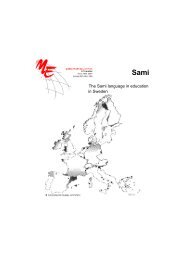Multilingual Early Language Transmission (MELT) - Mercator ...
Multilingual Early Language Transmission (MELT) - Mercator ...
Multilingual Early Language Transmission (MELT) - Mercator ...
Create successful ePaper yourself
Turn your PDF publications into a flip-book with our unique Google optimized e-Paper software.
needs of different types of learners, and the absence of such differentiation for L2 and L1<br />
learners compromises the value of native speaker competence in the minority language and<br />
essentially accords it the status of supporting L2 learning. Such prioritising of the needs of L2<br />
learners of the language without due regard for the use of the language among those<br />
already fluent will be shown to be counterproductive.<br />
Considering minority language use as well as acquisition<br />
Settings that involve mixing L2 learners of a language (who are native speakers of a majority<br />
language) with L1 speakers of an endangered or minority language have been studied in<br />
Wales (G.E. Jones (1991), Ireland (Hickey, 2001, 2007), Canada (Mougeon and Beniak, 1994)<br />
and in the Basque Autonomous Community (Zalbide and Cenoz, 2008). Where L2 learners<br />
and native speakers are mixed, research has identified some deficiencies in the provision for<br />
native speakers, such as lack of language enrichment in input that is simplified for L2<br />
learners, as well as insufficient promotion of the use of the language between mothertongue<br />
speakers of non-dominant languages. Thompson (2000) found that children from<br />
minority language backgrounds in her study established their initial friendships through their<br />
minority language, but over the course of a year in preschool, they shifted towards English in<br />
general and away from speaking only the minority language even with these friends. This<br />
points to the difficulty of maintaining minority language networks between children even<br />
when they have already been established, given the overwhelming influence of the majority<br />
language. Immersion preschools offering immersion in endangered languages, therefore,<br />
need to consider, not only the issue of how best to support children’s acquisition of the<br />
language, but also how to promote and maintain children’s minority language use when they<br />
are in situations of high language contact such as the preschool, which Hickey (2001, 2007)<br />
and Thompson (2000) show can be akin to unofficial English submersion. It is relevant to<br />
note that establishing and promoting ‘natural use of Irish’ among young children is a stated<br />
aim of Comhar Naíonraí na Gaeltachta Teo., the group which supports and oversees the<br />
naíonraí in the Gaeltacht.<br />
It has long been acknowledged (see, for example, Sylva, Roy and Painter, 1980) that<br />
preschoolers thrive in pairs and smaller groups rather than the type of larger class groups<br />
found in primary schools. Hickey (2005, 2007) discussed the language learning opportunities<br />
afforded by different types of grouping (individuals, pairs, small groups, larger groups, whole<br />
group, each with/without the Leader) depending on the type of play engaged in and the<br />
children’s level of target language competence. It is a highly demanding task to allow<br />
children to explore and learn by discovery, while offering developmentally appropriate<br />
language input, in conjunction with appropriate activities to promote learning through play.<br />
This demanding task requires planning that recognises the centrality of interaction in<br />
children’s language development. When the majority of children in a group are L2 learners,<br />
the Leader and Assistants are the primary sources of target language input, particularly at<br />
the outset, and these children will profit from an adult’s language scaffolding in order to<br />
acquire the language relevant to their activity when they are working alone, in pairs or in<br />
small groups (Mhic Mhathúna, 2008). On the other hand, children who are able to speak the<br />
target language can benefit from a different balance of activities with similarly fluent peers,<br />
provided that their use of the target language with such other children is actively monitored<br />
and promoted.<br />
106



